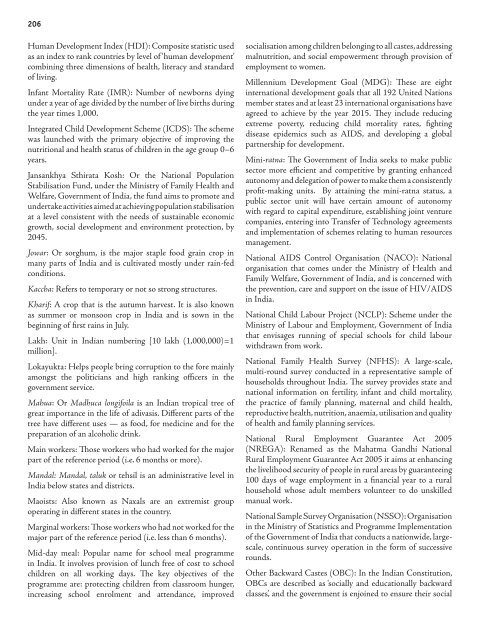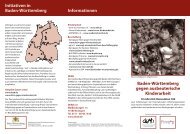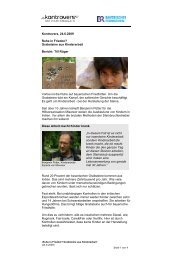Children - Terre des Hommes
Children - Terre des Hommes
Children - Terre des Hommes
You also want an ePaper? Increase the reach of your titles
YUMPU automatically turns print PDFs into web optimized ePapers that Google loves.
206Human Development Index (HDI): Composite statistic usedas an index to rank countries by level of ‘human development’combining three dimensions of health, literacy and standardof living.Infant Mortality Rate (IMR): Number of newborns dyingunder a year of age divided by the number of live births duringthe year times 1,000.Integrated Child Development Scheme (ICDS): The schemewas launched with the primary objective of improving thenutritional and health status of children in the age group 0–6years.Jansankhya Sthirata Kosh: Or the National PopulationStabilisation Fund, under the Ministry of Family Health andWelfare, Government of India, the fund aims to promote andundertake activities aimed at achieving population stabilisationat a level consistent with the needs of sustainable economicgrowth, social development and environment protection, by2045.Jowar: Or sorghum, is the major staple food grain crop inmany parts of India and is cultivated mostly under rain-fedconditions.Kaccha: Refers to temporary or not so strong structures.Kharif: A crop that is the autumn harvest. It is also knownas summer or monsoon crop in India and is sown in thebeginning of first rains in July.Lakh: Unit in Indian numbering [10 lakh (1,000,000)=1million].Lokayukta: Helps people bring corruption to the fore mainlyamongst the politicians and high ranking officers in thegovernment service.Mahua: Or Madhuca longifoila is an Indian tropical tree ofgreat importance in the life of adivasis. Different parts of thetree have different uses — as food, for medicine and for thepreparation of an alcoholic drink.Main workers: Those workers who had worked for the majorpart of the reference period (i.e. 6 months or more).Mandal: Mandal, taluk or tehsil is an administrative level inIndia below states and districts.Maoists: Also known as Naxals are an extremist groupoperating in different states in the country.Marginal workers: Those workers who had not worked for themajor part of the reference period (i.e. less than 6 months).Mid-day meal: Popular name for school meal programmein India. It involves provision of lunch free of cost to schoolchildren on all working days. The key objectives of theprogramme are: protecting children from classroom hunger,increasing school enrolment and attendance, improvedsocialisation among children belonging to all castes, addressingmalnutrition, and social empowerment through provision ofemployment to women.Millennium Development Goal (MDG): These are eightinternational development goals that all 192 United Nationsmember states and at least 23 international organisations haveagreed to achieve by the year 2015. They include reducingextreme poverty, reducing child mortality rates, fightingdisease epidemics such as AIDS, and developing a globalpartnership for development.Mini-ratna: The Government of India seeks to make publicsector more efficient and competitive by granting enhancedautonomy and delegation of power to make them a consistentlyprofit-making units. By attaining the mini-ratna status, apublic sector unit will have certain amount of autonomywith regard to capital expenditure, establishing joint venturecompanies, entering into Transfer of Technology agreementsand implementation of schemes relating to human resourcesmanagement.National AIDS Control Organisation (NACO): Nationalorganisation that comes under the Ministry of Health andFamily Welfare, Government of India, and is concerned withthe prevention, care and support on the issue of HIV/AIDSin India.National Child Labour Project (NCLP): Scheme under theMinistry of Labour and Employment, Government of Indiathat envisages running of special schools for child labourwithdrawn from work.National Family Health Survey (NFHS): A large-scale,multi-round survey conducted in a representative sample ofhouseholds throughout India. The survey provi<strong>des</strong> state andnational information on fertility, infant and child mortality,the practice of family planning, maternal and child health,reproductive health, nutrition, anaemia, utilisation and qualityof health and family planning services.National Rural Employment Guarantee Act 2005(NREGA): Renamed as the Mahatma Gandhi NationalRural Employment Guarantee Act 2005 it aims at enhancingthe livelihood security of people in rural areas by guaranteeing100 days of wage employment in a financial year to a ruralhousehold whose adult members volunteer to do unskilledmanual work.National Sample Survey Organisation (NSSO): Organisationin the Ministry of Statistics and Programme Implementationof the Government of India that conducts a nationwide, largescale,continuous survey operation in the form of successiverounds.Other Backward Castes (OBC): In the Indian Constitution,OBCs are <strong>des</strong>cribed as ‘socially and educationally backwardclasses’, and the government is enjoined to ensure their social






